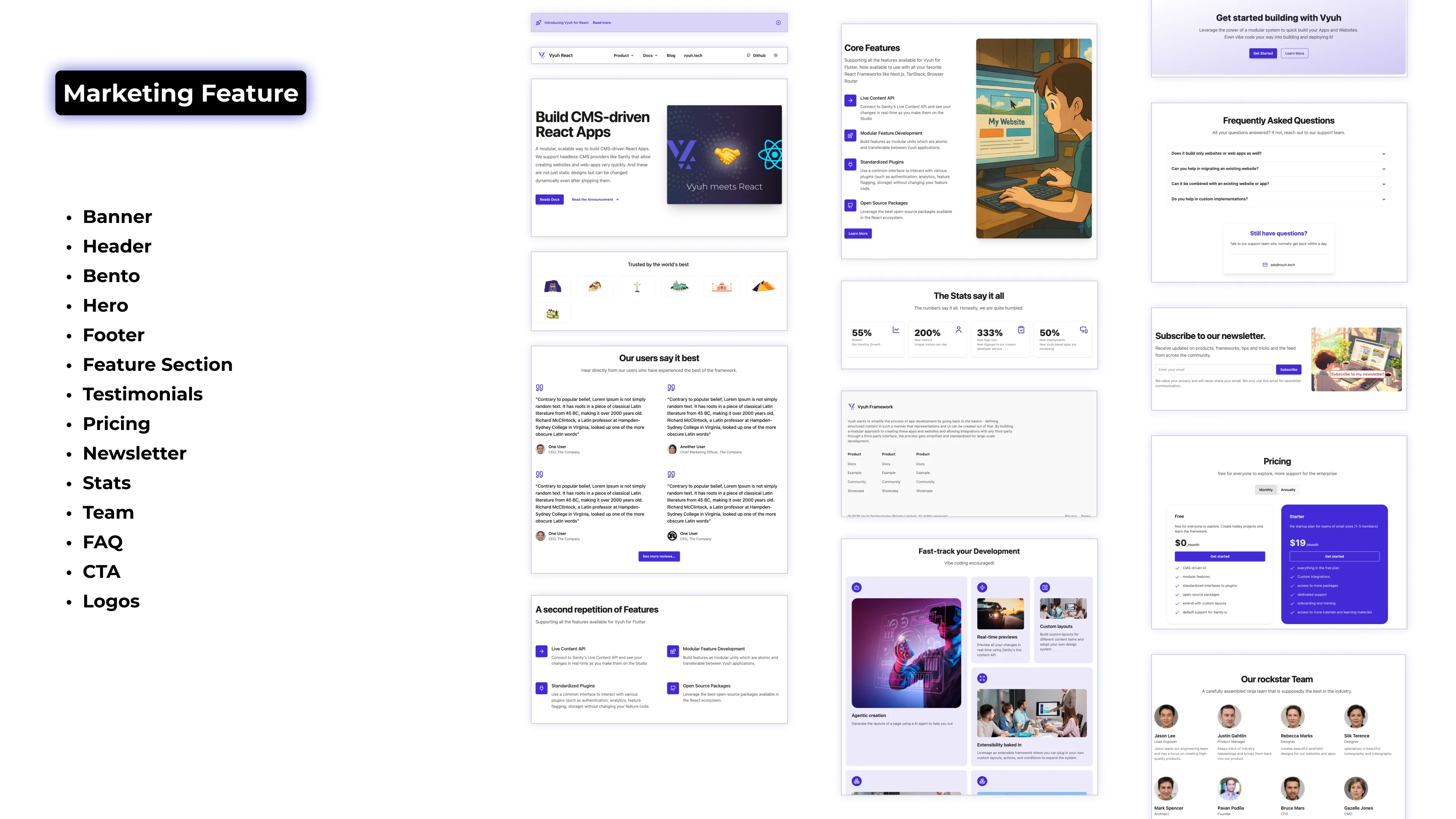Marketing Feature
The marketing feature provides a comprehensive set of content blocks designed for building marketing websites and landing pages. It includes components for common marketing sections like heroes, features, testimonials, and more.

Content Types
Section titled “Content Types”The marketing feature includes a comprehensive set of content types that work together to create complete marketing pages. Here’s the full list of content types provided by the marketing feature:
- Hero - Impactful page headers with calls to action
- Feature Section - Showcases product or service features
- Banner - Attention-grabbing notification bars
- Header - Navigation headers for websites
- Footer - Page footers with navigation and information
- CTA (Call to Action) - Conversion-focused action blocks
- FAQ - Frequently asked questions sections
- Testimonials - Customer testimonial displays
- Pricing - Pricing tables and plans
- Stats - Numerical statistics and metrics displays
- Team - Team member profiles and listings
- Logo - Logo displays for branding
- Bento - Grid-based content layouts
- Newsletter - Email signup forms
We’ll cover the top three content types in detail below, but you can explore the full source code on GitHub for more information about the other content types.
You can explore the full source code for the marketing feature on GitHub:
You can also view the complete marketing feature directory 🔗 in the Vyuh repository.
The Hero content type is designed for creating impactful page headers with calls to action:
// Hero content structureinterface Hero extends ContentItem { // The main title for the hero section readonly title: string
// A supporting text that appears below the title readonly subtitle?: string
// Media content (image or video) readonly media?: { type: 'none' | 'image' | 'video' image?: ImageReference video?: ObjectReference }
// Call-to-action buttons readonly actions?: Array<{ variant: 'primary' | 'secondary' | 'tertiary' | 'link' action: Action }>}Heroes are typically used at the top of landing pages to grab attention and direct users to key actions.
Feature Section
Section titled “Feature Section”The Feature content type showcases product or service features with supporting media:
// Feature content structureinterface Feature extends ContentItem { // The main title for the feature section readonly title: string
// A supporting description readonly description?: string
// List of individual features to highlight readonly features?: Array<{ title: string description?: string icon?: string }>
// Media content (image, video, or code example) readonly media?: { type: 'none' | 'image' | 'video' | 'code-example' image?: ImageReference video?: ObjectReference codeExample?: { code: string language: string } }
// Call-to-action buttons readonly actions?: Array<{ variant: 'primary' | 'secondary' | 'tertiary' | 'link' action: Action }>}Feature sections are versatile and can be used to highlight product capabilities, benefits, or use cases.
Banner
Section titled “Banner”The Banner content type creates attention-grabbing notification bars:
// Banner content structureinterface Banner extends ContentItem { // The main text to display readonly text: string
// Optional icon readonly icon?: IconName
// Call-to-action button readonly action?: Action
// Whether the banner can be dismissed readonly dismissible?: boolean
// Text for the dismiss button readonly dismissText?: string
// Unique identifier for storing dismiss state readonly cookieId?: string}Banners are useful for announcements, promotions, or important notifications.
Implementation Structure
Section titled “Implementation Structure”Sanity Studio Side
Section titled “Sanity Studio Side”In Sanity Studio, the marketing feature is defined with content descriptors and schema builders:
// Marketing feature descriptor for Sanityexport const marketing = new FeatureDescriptor({ name: 'marketing', title: 'Marketing', description: 'Schema for marketing components...',
// Content descriptors define available content types contents: [ new HeroDescriptor({ layouts: [defaultHeroLayout], }), new FeatureSectionDescriptor({ layouts: [defaultFeatureLayout], }), new BannerDescriptor({ layouts: [defaultBannerLayout], }), // More content descriptors...
// Route descriptor defines which content types can be used in routes new RouteDescriptor({ layouts: [fullPageRouteLayout], regionItems: [ { type: BannerDescriptor.schemaName }, { type: HeaderDescriptor.schemaName }, { type: HeroDescriptor.schemaName }, // More content types... ], }), ],
// Schema builders generate Sanity schemas contentSchemaBuilders: [ new BannerSchemaBuilder(), new HeaderSchemaBuilder(), new HeroSchemaBuilder(), // More schema builders... ],})React Side
Section titled “React Side”In the React application, the marketing feature is defined with content builders that render the content:
// Marketing feature descriptor for Reactexport const marketing = new FeatureDescriptor({ name: 'marketing', title: 'Marketing', description: 'Marketing components for building marketing pages', icon: 'layout-grid',
extensions: [ new ContentExtensionDescriptor({ contents: [ new RouteDescriptor({ layouts: [FullPageRouteLayout.typeDescriptor], }), ],
// Content builders render the content contentBuilders: [ new HeroContentBuilder(), new FeatureContentBuilder(), new BannerContentBuilder(), // More content builders... ], }), ],})The marketing feature provides a complete toolkit for building marketing pages. Content creators can use Sanity Studio to create and manage marketing content, while developers can use the React components to render that content in the application.
The marketing feature is designed to be used with the Vyuh framework’s content system. It works best when combined with other features like the blog feature for a complete website solution.

